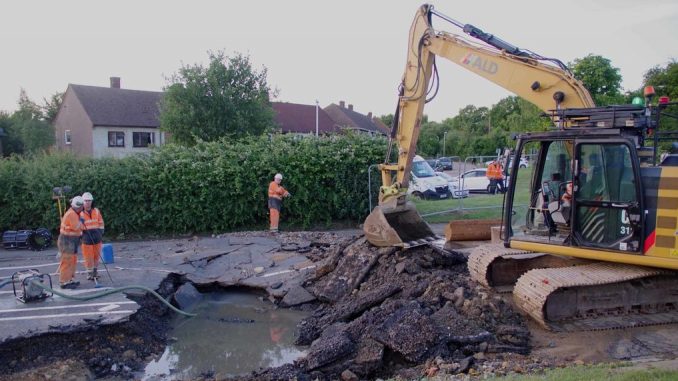
Water companies in the United Kingdom have been urged to sign up to a service which maps Britain’s underground assets to prevent damage such as pipe bursts occuring during construction and maintenance projects.
The Digging Up Britain report revealed that just 10 percent of the UK’s water network is visible to those who use the LinesearchbeforeUdig portal before their machinery hits the ground to avoid inadvertently cutting into something.
LSBDU is a free service which provides the location of underground assets and infrastructure across the UK. Any individual or organisation can use the portal to check their working area against electricity cables, gas pipes, high pressure fuel lines and fibre optic networks, allowing excavation to be carried out safely.
Over 2.8 million enquiries were carried out using LSBDU in 2019, an average of one search every 3.7 seconds of the working day. 71 percent of all digging tasks are now preceded by a search with LSBDU and over 90 asset owners have now registered their networks with the scheme including the National Grid, UK Power Networks, BP, Esso, Shell, Zayo and Gigaclear.
More than 80 percent of the UK’s gas network is covered by LSBDU and 70 percent of the nation’s underground electricity infrastructure is registered. When it comes to water however, just 10 percent of the network is visible, leaving more than 217,000 miles of uncharted pipes at serious risk of accidental breaches when excavation work is carried out.
The reluctance of water companies to register their assets on LSBUD is particularly strange given that preventing avoidable pipe leaks and bursts would help them to achieve the leak reduction targets imposed by the water regulator Ofwat.
In its five-yearly review into the industry released late in 2019, Ofwat told water companies that they had to cut the amount of water lost through leaks by 16% before 2025. By 2050, leakage levels must be half of what they were in 2020.
Allowing LSBUD to map the network and provide details of the location of water pipes to any individual or company who intends to dig down would be a clear way to prevent accidental breaches caused by third parties.
The question that the Digging Up Britain report asks is why water companies do not seem to be taking advantage of a tool which allows them to avoid having to carry out emergency pipe repair by ensuring that bursts do not happen in the first place? After all, prevention is better than a cure.
With Ofwat now treating pipework and asset failures caused by third parties as the responsibility of water companies, it is very much in the water companies interests to do as much as possible to stop those failures happening in the first place.
There are some signs that the message might be getting across. SES Water and Portsmouth Water both registered their underground networks on LSUBD in 2019, joining Northumbrian Water and Essex & Suffolk Water in making the locations of their assets freely available.
Richard Broome, managing director of LSBUD, commented upon on the publication of the Digging Up Britain report: “We hope the remaining utility companies recognise the benefits of sharing their information through our portal.”
“In terms of searching, we want to keep the momentum going and get even more people who are doing the digging, be they employees, contractors, or private individuals, to complete a search before any digging work begins. If we have change like this from both sides, and have everyone pulling in the same direction, assets and people will be safer.”

Leave a Reply